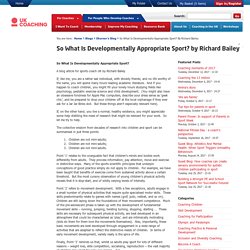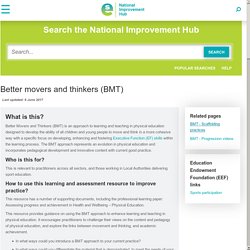

So What Is Developmentally Appropriate Sport? by Richard Bailey. So What Is Developmentally Appropriate Sport?

A blog article for sports coach UK by Richard Bailey If, like me, you are a rather sad individual, with shoddy friends, and no life worthy of the name, you will spend many hours reading academic literature. And if you happen to coach children, you might fill your lonely hours studying fields like psychology, pediatric exercise science and child development. Learn to Play in Schools - Physical Literacy - Webinar. Sport New Zealand Play Principles Nov 2017. 24-Hour Movement Guidelines for the Early Years: An Integration of Physical Activity, Sedentary Behaviour, and Sleep. Teach physical education everyday because it boosts the brain, say scientists Healthy Movers.
Healthy Movers is a suite of resources and training to support practitioners and families to develop the competence and confidence to ensure every child is physically literate.

The practitioner resource develops the confidence to ensure every child is physically literate and deliver the physical development component of the Early Years Foundation Stage (EYFS) Framework. Movement Assessment Tool on the App Store. Tackling childhood obesity is about more than just diet and exercise. A recent World Health Organisation report revealed that the number of obese children and adolescents – aged five to 19 years – worldwide has risen tenfold in the past four decades.

Worryingly, it also predicts that “obese” is likely to become the new norm. The report stated that: "If current trends continue, more children and adolescents will be obese than moderately or severely underweight by 2022. " The number of overweight or obese infants and young children increased from 32 million globally in 1990 to 41 million in 2016. The vast majority of overweight or obese children live in developing countries, where the rate of increase has been more than 30 per cent higher than that of developed countries. Children losing physical literacy – ECU Daily. The Sport for Life Society is recognized as the global experts on the Sport for Life movement, Long-Term Athlete Development, and physical literacy development. Physical Literacy. Physical Literacy Instructor Program - Sport for LifeSport for Life.
Program Overview The Sport for Life Society, Coaching Association of Canada, and HIGH FIVE® have come together to support recreation leaders, coaches and others in becoming a Physical Literacy Instructor.

Parliamentary group examines the important role of PE. An All-Party Parliamentary Group (APPG) on a Fit and Healthy Childhood has today released a new report which it has hailed as ‘the most comprehensive blueprint for PE for a generation.’

The APPG report, which includes contributions from the Youth Sport Trust, aims to recognise the vital importance of physical education to health and to create an the environment that will reverse the strong recent trend of reduced physical activity. The ways in which PE is taught in the four home nations and in other countries; the role of PE in the National Curriculum; ways in which girls can be encouraged to participate in PE; an inclusive PE curriculum for disabled children; and PE as part of a health and wellbeing matrix, including knowledge of good nutrition, sport and play; are among the subjects examined in the report. The report provides a series of recommendations to increase the delivery of high quality of PE in schools. PL Infographic ENG. Study: Active parents have more active kids. Better movers and thinkers (BMT) BMT – what does it do?

The BMT approach focuses on learning – the process and the product it helps to develop kinaesthetic awareness, which is essential when learning or developing physical skills, qualities and attributesit helps to engage the learners, and then sustain their engagementit supports learning by helping to develop thinking skills through movementit supports learning by helping to develop executive function skillsit supports the development of movement through the use of scaffolding practicesit enhances the development of performance through the practices of layering refinement and complexityit facilitates differentiation by focusing on the work of the individualit has the capacity to place physical education at the forefront of learning and teaching across the curriculum. Sit less, move more, sleep well Physical activity guidelines for children and young people.
Sit less, move more, sleep well Active Play guidelines for under fives. ClassPAL (Physically Active Learning) – Physical Activity and Public Health Research Group, Loughborough University. Healthy Movers. HANDS UP for Health and Physical Literacy. Physical activity needs to start from an early age. By Lindsey Turnbull The call for the general population to eat better and exercise more is falling on deaf ears and has been a “total public health failure” a new approach is needed if our population is to become healthier.

This was the message delivered by Dr Colin Higgs, at this year’s Healthcare Conference, which took place at The Ritz-Carlton at the end of October. Dr Higgs, Professor Emeritus with Memorial University, Canada, has worked with governments and NGOs in more than 50 countries, focusing particularly on the disadvantaged and those with disabilities. He has most recently been working to fundamentally redesign the Canadian sport system to improve the quality of sport in that country.
He began his presentation by stating that people generally undertook activities when they were good at the activity, while avoiding activities that they were bad at, so building competencies at a young age was the key to getting people to become fitter. Start Young Stay Active (PL with parents) Improving Physical Literacy (Sport Northern Ireland) What is physical activity in early childhood, and is it really that important?
We often hear messages in the media that children aren’t getting enough physical activity.

But what exactly does “being physically active” mean when you are an infant, toddler or preschooler? Theconversation. With sports lovers still basking in the gleam of Great Britain’s Olympic medal haul from Rio and now looking forward to a clutch of golds at the Paralympics, a BBC campaign is encouraging British school children to “Get Inspired” by Team GB’s success and emulate their sporting heroes.

However laudable this is, it comes amid a general decline in children’s basic skills at running, jumping, throwing, catching and kicking. Worrying findings across the world show that the movement skills of today’s children are less well developed than previous generations. Www.movingpeoplemore.com/See Me Do. Physical Literacy Measurement. Start Young Stay Active. Physical Literacy Assessment for Youth - PLAY Tools. Over-protective parents doing harm to their kids, speaker tells Sport Aurora summit. While many are quick to point a finger of blame at cellphones and video games for children’s sedentary lifestyles, one expert suggests adults should first take a long look in the mirror.

Drew Mitchell, physical literacy director for Canadian Sport for Life, addressed a crowd gathered at Seneca College in King last week during a physical literacy summit hosted by Sport Aurora. The audience represented stakeholders encompassing education, health, business, government and the sport-minded folks eager to discover the definition and practical applications of physical literacy.
“Kids want to move. It’s essentially their first language but, for the most part, they don’t because we, as adults, say they can’t,” Mitchell said. “Adults have become the barrier to activity.” Every day, children and adults are glued to screens and whether it be a cellphone, computer, tablet or TV, inactivity isn’t a physiological issue, it’s a behavioural issue, Mitchell added. Home - Run Jump Throw Wheel.
How to give your baby an active start - Active For Life. Does it seem odd to be thinking about raising an active child when your baby hasn’t been born yet or can’t even roll over on her own? As a new parent or new parent-to-be there’s a lot to think about and physical activity might seem like something that you can postpone focusing on about for at least a few more years. In the first year of life, your infant learns simple motor coordination skills that are essential to all aspects of her cognitive, emotional, and physical development.
She can’t be rushed but she can be encouraged in ways that will make being active easier when she gets a bit older. It’s a lot like setting the stage for a love of language and reading. Intuitively many parents talk to our babies, sing nursery rhymes and songs, and read stories to them, even when they are too young to make sense of what we’re saying (sometimes we do this even while they are still in the womb!). So how can you give your child the best start? From our experts: Teaching Games for Understanding (TGfU) Approach. The Teaching Games for Understanding (TGfU) approach was developed by researchers at Loughborough University in the United Kingdom to tap into children’s inherent desire to play. Bunker and Thorpe (1982) developed TGfU around the concept of teaching kids games by playing games. Butler et al. (2008) identified six Basic TGfU Concepts: Teaching Games for Understanding - Resource.
Lay the foundation for an active life. In today’s society, participation in physical activity isn’t very high on the daily list of priorities, even though we all know the amazing benefits of heart-pumping activity like increased fitness, reduced risk of chronic disease, and improved mental health and well- being. Introduction - Better movers and thinkers.
This video perfectly explains why every child needs physical literacy - Active For Life. If you’ve never heard of physical literacy, or have tried to explain the concept to someone who hasn’t, you know that it can seem a little complicated. Have a Ball Together.